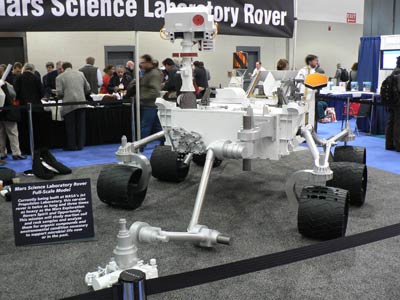 Problems with the management of missions like the Mars Science Laboratory are hardly the first examples of bad management and implementation. (credit: J. Foust) |
Reinventing failure
by Wayne Eleazer
Monday, December 22, 2008
Taylor Dinerman’s article “Alan Stern and the nature of the space industry” (The Space Review, December 8, 2008) points out that the problems identified in Mr. Stern’s earlier article are less associated with the innate perils of new technology than they are with people. As he puts it “…the fundamental reason for the problems that we see just about everywhere in the industry is human, specifically a lack of brilliant engineers.” Let me amplify and add something to those remarks.
The crowning achievement of Vice President Al Gore’s many years of government service was an effort called the Reinventing Government Initiative. Passed by Congress and implemented by the Clinton Administration in the early 1990’s, Reinventing Government on the surface looked like yet another buzzword-driven efficiency drive, in the spirit of Zero Defects and Total Quality Management, but it was much more than those earlier efforts.
The basic idea behind Reinventing Government was stunning in its simplicity. Just get rid of 30% of the federal government workforce and the remaining 70% simply would have to become more efficient. And that was that.
Implementation used a common Washington DC tactic, called the “peanut butter spread.” Congress did not do the hard and politically dangerous work of figuring out where to cut the fat. They told the Executive Branch to do it. The White House just told the various federal departments to get with the program and imposed an across-the-board 30% cut on all of them. The federal departments handed that cut down from on high to all the subordinate units and they in turn handed it down to the individual managers.
| Certain provisions of the Initiative sounded like they must have been invented by the old KGB. Workload did not matter; you still had to cut your workforce by 30%. |
So, no one in DC had to do the really difficult task and ask just what parts of the federal government were good for, anyway. No one asked why the Agriculture Department had as many employees as there are farmers in the US. No one had to figure out just what the Commerce Department was for. No one had to ask why the Education Department never educated anyone or if the Energy Department had actually produced any energy. No one had to answer just why we still needed a National Screw Threads Standardization Board or a Rural Electrification Agency. Everyone just had to cough up 30% of their workforce. Except for Congress, that is; they exempted themselves on the basis that they “gave at the office” or something like that.
Certain provisions of the Initiative sounded like they must have been invented by the old KGB. Workload did not matter; you still had to cut your workforce by 30%. The Department of Defense was in the throes of a reduction in force that would amount to some 40%, but that did not count; the 30% cut would be in addition to that 40% reduction. You could not refuse to do assigned work and you could not simply contract things out due to a shortfall in personnel. No relief was given from federal regulations or Congressionally-imposed directives—the bureaucracy would endure and pork would go on! During the Reagan Administration the Excellent Installations program allowed units to identify regulations that were a problem and then develop alternate local procedures instead, but that idea was not continued.
A workforce struggling to comply with a 30% reduction that was so disconnected from reality does not attract or produce “brilliant engineers” or for that matter, competent janitors. The Columbia Accident Investigation Board noted that NASA inspectors for the shuttle had been cut by 25% in the preceding years. Clearly someone should have launched an immediate investigation as to why NASA had not complied with the mandatory full 30% reduction.
Wayne Eleazer spent 25 years in the US Air Force, serving as the Thor program manager, GPS integration manager, Atlas test director at Vandenberg Air Force Base, and led the space launch section of the Air Force Acquisition Directorate of the Secretariat in the Pentagon. Prior to his retirement in 1999 at the rank of lieutenant colonel, he served as chief of advanced planning of the 45th Space Wing at Patrick Air Force Base, Florida, responsible for initial planning of EELV and other launch operations at Cape Canaveral.
|
